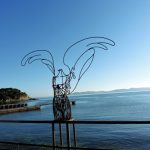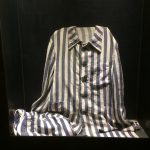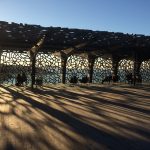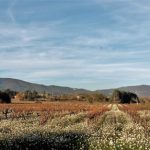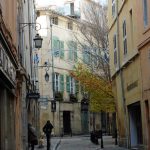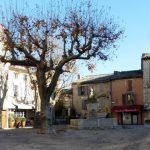We spent two days in the old city of Avignon in a self-contained apartment. Inside the old walled city was a fascinating rabbit warren of streets of little squares and ancient buildings. There’s a curious mix of old and new within the old city. Thankfully some of the modern apartment complexes are hidden behind high walls.
You can find a variety of hotels and apartments here:
Les Halles

On our first morning in Avignon, we discovered Les Halles (the markets). It became our breakfast location. With fresh croissants, pan au chocolate and gasseute (a type of pastry with a flavoured filling) we’d descend on one of the cafés. Inside the markets, there were three which were always overflowing with people. It wasn’t a drama about buying food from elsewhere they happily supplied coffee and alcohol. They were just like the Bar Tabac’s a place for locals to have a pick me up coffee or drink.
The French love their food and as such marketplaces such as Les Halles are always packed with people. It’s quite fascinating looking at the large array of food. Many of the foods which in Australia are no longer popular are on sale. As we’ve become richer the cheaper cuts of meat are no longer on the shopping list. At the butchers’ pigeons, pigs trotters, lambs feet, liver, kidneys, tripe, tongues, andoulluse sausages, blood sausages, white sausages, all different types of salami-type sausages, were all on display.

Nearby Le Maison de frommage proudly boasted 250 varieties of cheeses. There were so many different types that just choosing one was almost impossible. Despite the large selection of cheese there were a few other stalls also selling cheese. The fishmongers had an amazing array of seafood. oysters, mussels, sea urchins, cockles, different types of clams, sea squirts, prawns, langoustines, scallops, swordfish, salmon, flatfish, Dorado, redfish, mackerel, gurner, pilchards, anchovies and many other varieties. It was amazing just how many different types of seafood were on sale. It also said how popular these markets must be.
Some of the stalls sold precooked meals which looked amazing. There were all different sorts which we’d never seen on a menu. We could only guess that many were local home recipes.
The various greengrocers were not to be outdone and they offered a large selection vegetables. Unlike the large supermarkets, there was a selection of different varieties of the same fruit and vegetables. It was fascinating seeing green, yellow, white and pointed cauliflower varieties on sale.
Six varieties of pears, eight varieties of potatoes, ten varieties of apples. Each with its unique flavour and use. It’s something that is missed with the current push to make fruit and vegetable types multipurpose. If you’ve ever mashed a high starch potato and ended up with glug you’ll know what I mean.
As Avignon is so close to the Mediterranean it was no surprise that olives, olive oil, wines and spices were all on sale. Another Mediterranean influence was, of course, the spice shop. With mounds of rock-salt, different coloured spices, blends and smells. mmm magnificent.
Palais des Papes

Avignon was home to seven successive popes between 1309 and 1377. During that time Avignon wasn’t part of France but part of the kingdom of Arles. A situation arose that a dispute between the King of France and Pope Boniface VIII put France at odds with the Holy Roman Empire. After Boniface’s death, the new Pope Benedict XI only lasted eight months before he too died. It swung the pendulum in Frances favour and as an act of appeasement a Frenchman was elected and became Pope Clement V. He stated that at that time Rome was too dangerous to travel to so established his papacy in Avignon.
A grand popes palace (Palais des Papes) was built in Avignon and up until 1377 successive popes ruled from there. All of which were French. It was an era where the French King and the Pope worked for hand in hand. Clement V and the French king arrested, tortured and burned at the stake hundreds of Knights Templar. At that time the Knights Templar were an order who had developed a considerable wealth through banking. One of their lenders who was deeply in debt was the French King. So with the help of the Pope, he simply cleared his debts and the order was disbanded by the pope in 1312.

Pope Gregory XI returned to Rome in 1376 ending the period known as the Avignon Papacy. The French weren’t too happy and after his death in 1378 established two of their own popes in Avignon until 1423. These two popes known as Clement VII and Benedict XIII were known as antipopes. It created a schism in the church, with french antipopes reigning with limited power until 1473. By the time the French revolution broke out in 1789, the Palais des Papes was in a poor repair. It was seized and ransacked by revolutionary forces. During the revolution, it was the scene of a massacre of counter-revolutionaries. Under Napoleon, the Palais des Papes became a prison and barracks.
These days all that’s left of Palais des Papes, are the impressive gothic buildings which once housed the Avignon popes. It contains a museum and is quite popular with tourists.
Cathédrale Notre-Dame des Doms

These days all that’s left of Palais des Papes, are the impressive gothic buildings which once housed the Avignon popes. It contains a museum and is quite popular with tourists. Above the old Popes Palace is Avignon’s Cathédrale Notre-Dame des Doms. It was built in the 12th century in Romanesque design with a tall square tower which features a gilded statue of the Virgin Mary on the top.
Surprisingly it’s quite simple inside maybe due to its abandonment during the French Revolution.
Rocher des Doms

Above the Cathedral is the park known as Rocher des Doms. With small cafe’s surrounding duck ponds, trees and walkways winding brought gardens it’s a place to escape the heat of the city. The gardens were laid out in the 19th century and many of the features such as the grotto still remain.
From the Rocher des Doms, we had a great view over the Rhône River and the bridge which the song ” sur le Pont d’Avignon” was written about.
The Pont d’Avignon

The Pont d’Avignon ( Avignon Bridge Avignon) dates from the early 13th century. It replaced an earlier bridge destroyed by Louis VIII when he laid siege to Avignon. The replacement bridge was built of stone and featured 22 arches. The bridge was destroyed by floods on the river Rhône and rebuilt a number of times. In the 17th century, the Pont d’Avignon was eventually abandoned. These days just the four spans of the Pont d’Avignon remain. But like the song says people still dance ” sur le pont d’Avignon”.
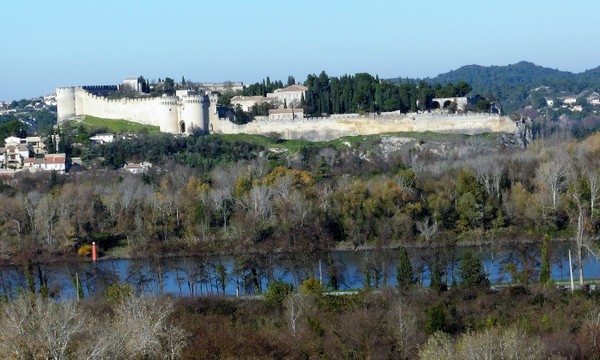
From the viewpoint you also get an amazing view of the river to Villeneuve-les-Avignon a fortifies town nearby. Villeneuve-les-Avignon can be reached by public transport and apparently is worth a wander around as well.
Jean Althen
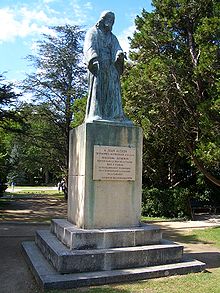
At Rocher des Doms is a statue of Jean Althen, an 18th-century Armenian agronomist. He was responsible for revolutionising the production of madder in Avignon. Madder was an important red dye used in the textile industry which was a major industry in Avignon. Beneath the walls and along Rue des Teinturiers, also known as the street of the waterwheels, the Sorgue river flowed. At one stage the Sorgue River turned the waterwheels of around thirty or more textile mills. These days four wheels are a reminder of the past and the street is now home to lots of restaurants and bars.

Over the two days in Avignon, we explored many of the streets around Avignon. Along Rue de Republique all the big name shops cater to the tourists selling all the high-end products. Just off the Hotel De Ville, the cobbled streets lead to Rue des Marchands. In the streets surrounding des Marchands are lots of lovely boutique style shops and cafes. It seemed that around every corner we’d discover a little square, a church, steer art or a cafe.
Tomorrow we head to Aix-De-Provence, an area which Michele is in love with although she’s never been. She fell in love with the area after watching the Russell Crowe film “A Good Year” so we are going to explore some of the filming locations which should be fun.

